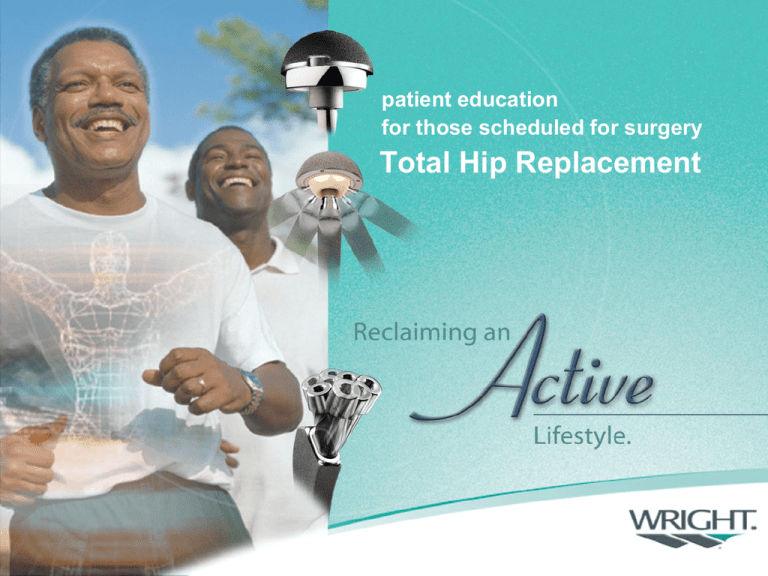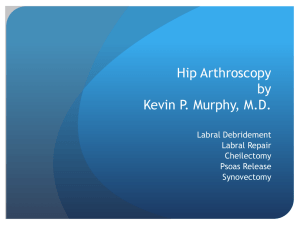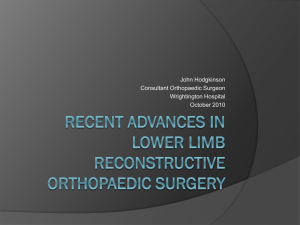Hip_PatientEd
advertisement

patient education for those scheduled for surgery Total Hip Replacement patient education for those scheduled for surgery Discussion of Arthritis What Are The Major Causes of Joint Pain? Osteoarthritis Post Traumatic Arthritis Rheumatoid Arthritis Avascular Necrosis Paget’s Disease Systemic Lupus Osteoarthritis of the Hip Ligaments Femur Pelvis Femoral Head Healthy Hip Diseased Femoral Head Arthritic Hip Total Hip Replacement: The Implant Ligaments Acetabular Cup & Acetabular Head Femur Stem Pelvis Femoral Head Healthy Hip Modular Neck Post-Surgery, with BFH® Implant Total Hip Replacement: Animated 1. To load animation, rightclick on the animation box. Select “Play”. 2. Use mouse and click on “see step-by-step” to walk through animation. After animation is completed, click twice on slide background to move forward to next presentation slide Surgical Pro’s Major Improvement: Pain - Less or no pain medication Return to normal, daily activities Fitness & recreation patient education for those scheduled for surgery Discussion of Surgery Preparation for Surgery Advance preparation helps reduce complications both during and after the operation A well informed patient recovers quicker, and studies show this Medical evaluation & diagnostic tests will be performed Think Ahead Special parking permit? Discuss this with your surgeon Prepare your body Prepare your home Preparing for Surgery: Your Body Medications: Advise your surgeon of all medications you're currently taking, prescription or over-thecounter. Prepare Your Skin: Your skin should be free of any infections or irritations before your surgery. Donate Blood: Although not critical, you may choose to donate blood in case you need a transfusion after surgery Finish Dental Work: If possible, finalize all dental work before your hip replacement surgery. Preparing for Surgery: Your Body Lose Weight: If you are overweight, it's a good idea to drop some pounds before surgery if possible. Stop Smoking and Drinking: It's advisable to quit smoking - or at least cut back - prior to your operation. Don't drink alcohol for at least 48 hours prior to your surgery. Urinary Evaluation: If you have a history of frequent urinary infections, schedule a urological evaluation before your surgery. This is especially important for men with prostate disease. Exercise: Exercise prior to surgery to increase your strength, so you will have flexibility to exercise after your surgery. Preparing for Surgery: Your Home Rearrange Furniture: Create wide traffic paths and remove obstacles Check your shoes: Wear rubber-soled shoes to prevent slipping Remove electrical cords: To avoid tripping, remove them, hide them or tape them to the floor Pack up the throw rugs: Rugs can shift or bunch, causing you to slip or trip. Watch the floor: Always keep an eye on the floor to avoid tripping over pets or small objects. Purchase assistive devices: i.e. long handled grabber, raised toilet seat, shower bench, hand grips Preparing for Surgery: Your Home Stock up on food: Store all supplies between waist and shoulder level to avoid bending. Prepare a bed downstairs: Prepare a bed on the ground floor of your home to use temporarily Get help with household chores: Arrange a short stay at an extended care rehab facility or ask family and friends to help out. Insurance: Check with your carrier in advance to see if you need precertification for surgery, as well as whether your insurance plan covers a private room Preparing for Surgery: Your Home Don’t forget your pets: Arrange for someone to care for them. You don't want to trip over them or have them possibly knock you down, and you may have problems picking them up or cleaning up after them. The Day of Surgery Plan to arrive at the hospital 2 hours prior to surgery to fill out pre-admission paperwork. Make sure you bring: Your health insurance card A list of your medications and any allergies Your living will or power of attorney Emergency contact info The Day of Surgery Don't wear jewelry or makeup Remove nail polish, dentures and contact lenses or glasses Do not use lotion, perfume or deodorant Don't eat or drink anything after midnight on the night before your surgery You may brush your teeth and rinse your mouth, but don't swallow any water Before Surgery After the paperwork is completed, your nurse will review your personal health history and your home medications with you. It's important that you share any recent changes in your health. You'll also be asked to remove your clothing and put on a hospital gown. Then you'll be assigned to a bed in the preoperative holding area. Preoperative Holding A nurse will start an intravenous infusion An anesthesiologist will discusses with you the type of anesthesia best for your case Anesthesia is designed to make the procedure as comfortable as possible for you general anesthetic (asleep) spinal anesthetic (awake, but no feeling from waist down) Preoperative Holding Answer questions: Regarding your medication, allergies, medical history, and your vital signs will be taken. Receive medication: You'll be given medication to help you relax. Say goodbye to your family: They'll be taken to a waiting area where they can be kept informed of your progress during surgery. You'll then be wheeled into your operating room. The Procedure – Operating Room In the OR, you'll be moved from your gurney onto the operating bed Temperature is intentionally cool to help prevent infections Nursing team will cover you with blankets to keep you warm EKG electrodes will be placed on your chest and sides to monitor your heart Then the anesthesiologist will inject medication through your IV line. A nurse may insert a urinary catheter - a thin, sterile tube inserted into your bladder to drain urine. The surgery itself generally takes between 45 minutes to 2 hours. The Procedure – Operating Room Surgeon determines what length of incision will be needed. Minimally-invasive surgery technique (2-3 inches) preserves vital muscles & tendons less pain, scarring, blood loss, and increased function immediately after surgery. Traditional hip surgery (6-8 inches) The Procedure - Recovery Room You'll awaken slowly in the recovery room, where you'll spend your first hour or two after surgery. Your nurse will constantly monitor your progress to ensure that your vital signs are stable. The Procedure - After Surgery After the recovery room, you'll be taken to your hospital room. Bulky dressing over the surgical incision and may have a drain in place to help decrease swelling of your hip. Your heels will be elevated to decrease pressure on the surgically repaired hip. You'll also be hooked up to an IV line, through which you'll receive fluids and medication (including an antibiotic). The Procedure - After Surgery You'll remain in bed sitting up with nurse's assistance Nursing team will regularly turn you and provide skin care Be sure to tell them if you experience any tender or burning areas Start your home medications as soon as you can tolerate liquids Diet will be initially limited, the range of foods available to you will increase as your appetite returns Medications will help reduce any nausea Hospital Stay Day after your surgery Technician will draw blood; IV fluids and medications will continue Nurse will help you to move into a reclining wheelchair Second day after surgery Nurse will remove your incisional drain and catheter IV fluids may be stopped, and social services will discuss discharge planning with you Third day after surgery Most patients discharged You'll be able to visit the bathroom with walker Staff will show you how to maintain proper hip alignment using the toilet Hospital Discharge Your nurse will change your dressing and teach you on how to care for your incision site at home Your pain medication pump will also be discontinued. You’ll receive discharge orders and instructions. If you are not discharged to your home, you'll go to a rehab unit, extended care or skilled nursing unit Your Healthcare Team During your surgery and rehabilitation, you'll work closely with a healthcare team that includes the following people: Orthopaedic Surgeon: surgery and recovery Nurses: Pre and post-op surgery and pain management Physical Therapist (PT): Muscle strengthening and exercise Occupational Therapist (OT): Daily activity management Case Manager: Discharge Pain Management Ask for pain management BEFORE the pain becomes too intense to handle Fatigue decreases your tolerance for pain, so avoid becoming overtired Pace your activities to allow for rest periods If you're not sleeping well, inform your nurse Your doctor may prescribe medication Patient-Controlled Analgesia. Patient-controlled analgesia (PCA) provides optimal pain relief without the use of injections Intravenous, continual, small dose of pain medication Small, computerized pump allows you to selfadminister an additional amount of medicine as needed All you have to do is push a button Increasing Muscle Strength Key to rehabilitating your hip A physical therapist (PT) will visit you to Review essential exercises Cover what to expect from your first therapy session Answer any questions. You'll begin walking and other exercises a day or two after surgery In most hospitals, therapy is performed twice a day. Body Alignment Proper body alignment helps lessen pain Nursing staff will help you change position at frequent intervals to maximize comfort Don't try to turn on your own following surgery, ask for help whenever you want to shift position Keep a pillow between your legs when sleeping. Pain Medications Several types of anti-pain medications: narcotic and non-narcotic pain relievers, muscle relaxants and antiinflammatories Administered through injections, in pills or via an IV tube Your doctor may prescribe a combination If medication does not successfully control your pain, alert your nurse Pain Medication Side Effects Most common side effects of pain medications: upset stomach, nausea, constipation and drowsiness Always take medication with something Milk, juice, crackers Choose HIGH FIBER foods and fruit juices Drink 5-6 glasses of water daily If no bowel movement in 3 days, inform your nurse Prevention of Infection The risk of infection following hip surgery is low, however it's important to take the possibility seriously. Notify your orthopaedic surgeon if: The incision site has drainage, redness, swelling and/or foul odor. You think that you may have an infection. an ingrown toenail, bladder infection, skin sores, a tooth abscess, etc. You have ncreased hip pain at rest or when active. You undergo a procedure through which bacteria might spread into your bloodstream. You have a persistent fever above 101°F for 2 days. Deep Vein Thrombosis (Blood Clots) Notify your orthopaedic surgeon if you have blood clot symptoms: Chest pain Shortness of breath Drainage or foul odor from the incision Redness at the incision site Redness, warmth or pain in legs Excessive pain or swelling in the hip, calf or feet Elevated temperature of more than 101ºF Rehabilitation Rehabilitation can take weeks or months Dependent on the state of your health before the operation How well you follow the rehab regimen Be cautious with your new hip and avoid overly strenuous or prohibited activities Be patient - your recovery will take some time and effort You should again be able to enjoy most of the same activities you did before hip pain Rehabilitation Using a Walker: Start slowly by moving the walker a few inches in front of you, taking small, even steps Using Crutches: Require a considerable amount of upper body strength, so their use is advisable only for certain patients Exercises: Your physical therapist will show you exercises designed to strengthen your muscles and increase your range of motion When to Call Your Doctor If you experience swelling around the surgical incision, or in a calf or leg If you have unusual hip or leg pain If the incision leaks fluid If you have trouble breathing or experience chest pains If you have fever over 101ºF for 2 days patient education After Hip Replacement Living With Your New Hip - Diet May experience some loss of appetite Eat a healthy, balanced diet Advisable to take an iron supplement or eat ironrich foods to help restore muscle strength and promote tissue healing Drink plenty of fluids New Hip – Getting Into Vehicles Make sure that the passenger seat is pushed all the way back in your vehicle Lower yourself carefully onto the seat, keeping your operated leg forward and allowing the seat to support you Slide back onto the seat in a semi-reclining position and pivot your body so that you're facing the front of the vehicle Pull your legs into the vehicle one at a time New Hip - Walking Back to Health Walking is essential to your recovery Make walking part of your daily routine, gradually increasing the amount of time you spend doing it Focus on walking heel to toe with a smooth motion, spending equal weight and time on each foot As your recovery progresses, move on to more advanced activities, like stairs New Hip - Aids to Assist You Bathing: Your therapist or nurse will show you how to use a shower bench or chair while bathing. Use a long-handled sponge, shower hose or handheld showerhead to make bathing easier. You may also want to consider having grab bars installed in your shower or bathtub to provide support as you get in and out. Hand Grips: Install handrails or safety bars next to stairs. If you already have these in place, secure them firmly before your surgery. New Hip - Aids to Assist You Toilet: Use a raised toilet seat to keep your hip in a more stable position and minimize bending. Dressing: To avoid bending, try to dress while sitting on a chair. A sock aid and long-handled shoehorn can assist you. Housekeeping and Cooking: Use a long-handled reacher or grabber for objects too high or low for you to to reach without stretching or bending. New Hip - Best Standing Positions When stepping up on a curb, move as close to your walker as possible, then put your weight on both legs and lift it onto the sidewalk. Step onto the sidewalk first with the un-operated leg. Using the walker to support your weight, bring up the operated leg. Use your good leg first in walking up stairs, then bring your operated leg up to meet it. When going downstairs, always step down with your operated leg first. New Hip – Best Sitting Positions To sit, back up until the edge of the chair or bed touches your leg. Then, using the armrests to support your weight, lower yourself into a sitting position. To stand, reverse these steps. Use a firm chair with a straight back, armrests and a high seat. Always sit with your knees level with or lower than your hips. (Don’t cross your legs.) Always sit with your back upright. Keep both feet on the floor and your hips 6 inches apart. Don't let your hip cross the midline of your body. New Hip – Getting Out of Bed Get out of bed on the side of your prosthetic hip, keeping your thighs apart. Pivot on your hips, using your arms to help. With your good leg, gradually scoot to the edge of the bed. Keep your operated leg out to the side. Do not twist it inward. Sit on the edge of the bed with your operated leg slightly forward. With your hands behind your hips, push up - without bending forward - to stand up. New Hip – Using the Toilet When using the toilet, step back until you feel the toilet touch the back of your legs. Place your operated leg in front of you, keeping your weight on the other leg. Looking behind you, grasp the side rails and lower yourself onto the front of the toilet, then edge back. To stand up, reverse these steps. New Hip - Intimacy Partial hip replacement patients may resume sexual activity when comfortable, as restrictions are minimal. Total hip replacement patients may usually resume sexual activity 4-6 weeks after surgery. Always ask your doctor first, though, as this timeframe varies depending on your type of prosthesis. Frequently Asked Questions When will my staples be removed? Staples are removed approximately 10-14 days after your surgery. How long do I wear the white support stockings? This varies by doctor and individual recovery times. Generally speaking, the stockings should be worn during the day, but can be removed at night. If there is no swelling after 2-3 weeks, use can be discontinued. Frequently Asked Questions When do I start physical therapy? It varies by case and by doctor. Ask your surgeon for his preference. How much weight will my surgical leg bear? It depends on the type of surgery and your doctor's individual preference. Usually, partial weight bearing is recommended. Frequently Asked Questions When can I drive? This also varies by doctor and also depends on the type of surgery performed. Usually, you'll be able to drive within 2-6 weeks - your doctor will let you know when it's safe. When can I swim? Most doctors agree that you should wait 6 weeks before beginning active swimming. However, walking in water is great rehabilitative exercise. Frequently Asked Questions When can I take a shower? You may shower after surgery. Leave the dressing in place. Afterward, remove the dressing, dry completely, clean thoroughly with peroxide and apply a clean dressing. Do not take a bath until your staples have been removed and your incision is healed. How long after surgery will I need to take antibiotics prior to dental work? For the rest of your life. It's recommended that you have any dental work done prior to surgery, if possible. thank you







